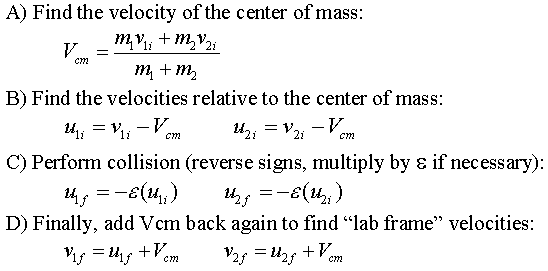
|
|
Description
There are two masses that can collide inelastically - you can adjust
the coefficient of restitution from 0 (completely inelastic - they stick
together) to 1 (completely elastic - bounce apart, and conserve KE). You
can specify the initial velocities and masses for each mass, and the
coefficient of restitution. (The arrow buttons near the initial values
will double or half the values. If you manually change a value {not using
the arrows}, click the UPDATE button.)
Center of Mass view : This applet adds a
view in the center of mass frame. The initial relative velocities are
found by subtracting the Vcm from each mass's velocity. To perform the
collision, we reverse the sign of the initial relative velocity, and
multiply by the coefficient of restitution - this will give the relative
velocity after the collision (notice if the coefficient is zero .. there
is no relative velocity afterward .. and thus they are stuck together at
the center of mass!). We could then add the Vcm to the final relative
velocities to get the final lab frame velocities. Also, watch the white "X"
that is moving in the black rectangle underneath the two masses in the lab
frame .. that is the location of the center of mass of the two masses (it
should have a constant velocity). The bottom center of mass frame is what
you would see if you traveled along with that white X and looked at the
motion of the masses relative to your position. Those relative velocities
can be found with the following steps illustrated below :

Some things to notice as you watch the collisions in the lab frame (top) and the center of mass frame (bottom) :
Related Physlets :
Conservation
of Momentum - Energy to Separate (momenta1)
Setting
the Explosion energy between two masses (momenta2e)
Conservation
of Momentum - 2 Mass Elastic Collision (momenta3)
Conservation
of Momentum - 2 Mass Inelastic Collision (momenta3c)
Conservation
of Momentum - 2 Mass Inelastic Collision - Center of Mass Technique
(momenta4)
Of the 863 visitors, you are the most recent!